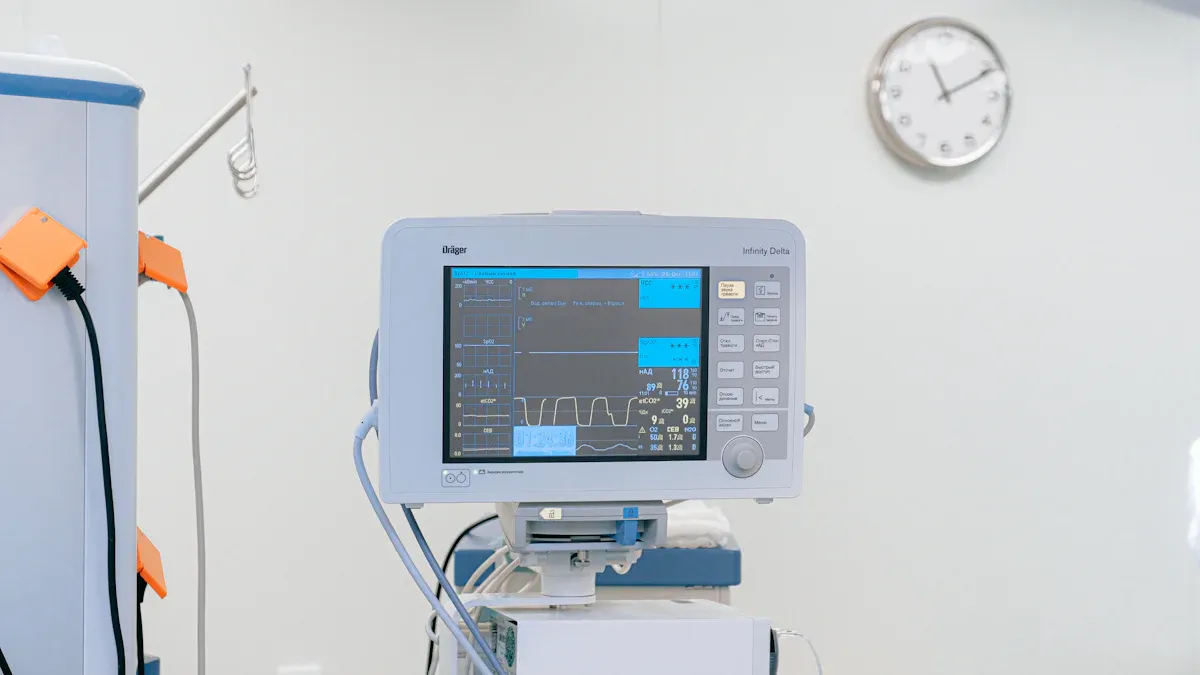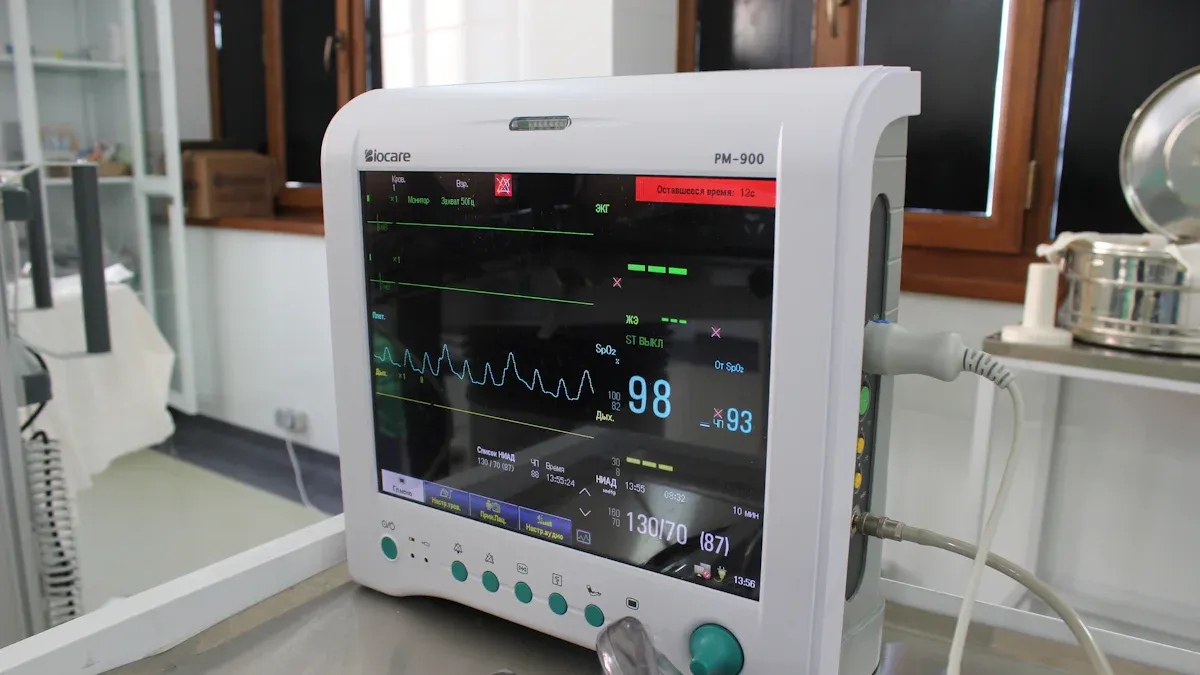The processing requirements of pcba for medical equipment

Printed Circuit Board Assembly (PCBA) is crucial for medical devices. These assemblies must meet strict processing requirements to function effectively and maintain safety. Standards such as ISO 13485 and IEC 60601-1 ensure safety and quality. Specialized boards, like HDI and Rigid-Flex, facilitate compact designs for medical tools. Adhering to IPC-6012 guarantees that these boards are robust and dependable during critical operations.
Key Takeaways
PCBA is important for medical devices and must follow strict rules like ISO 13485 and IPC Class 3 to stay safe and reliable.
Using safe materials is key for medical PCBs to avoid bad reactions in patients and make devices work better.
Making PCBs in cleanrooms keeps them clean, meeting safety rules and helping them work well.
Types of PCBs Used in Medical Equipment

HDI (High-Density Interconnect) Boards
HDI boards are important for small and reliable medical devices. These boards are used in tools like implants and diagnostic machines. They fit many parts into tiny spaces because of their smart design.
Making HDI boards is tricky. Problems like short circuits can happen due to their complexity. These issues can stop medical devices from working properly. Even small mistakes can be dangerous for patients. To avoid this, manufacturers test and check these boards carefully.
Rigid-Flex Boards
Rigid-flex boards mix strong rigid boards with bendable flexible circuits. This makes them great for medical tools that need strength and flexibility. They are used in wearable devices and surgical tools because they can bend and fit different shapes.
These boards also remove the need for extra wires and connectors. This makes the design simpler and more reliable. Their lightweight and flexible design is perfect for portable medical devices. These devices need to be easy to carry and use.
Specialized PCBs for Medical Applications (e.g., Multilayer, Flexible PCBs)
Special PCBs, like multilayer and flexible boards, are common in medical devices. Multilayer boards have many layers, which allow for complex designs. They are great for small devices with advanced features.
Flexible boards can bend and fit curved surfaces. They are light and work well in imaging tools and wearable monitors. Below is a table showing their benefits:
PCB Type | Description |
|---|---|
Multi-layer flex-rigid | Works for advanced devices used in medical technology. |
Compact design | Fits many parts into small spaces for medical tools. |
Higher circuit density | Adds more features in less space. |
Special PCBs are used in machines like CT scanners and MRI devices. Their ability to handle complex designs helps medical tools work well in serious situations.
Importance of IPC Class 3 Standards in Medical PCBA
Overview of IPC Class 3 Specifications
IPC Class 3 standards are vital for medical PCBA reliability. These rules ensure PCBs meet top-quality levels for critical uses. The IPC-6012EM addendum is made for medical devices. It sets strict rules for rigid boards' performance and testing. This global standard focuses on durability, cleanliness, and traceability. It ensures every PCB made under IPC Class 3 is safe for healthcare.
Why IPC Class 3 is Critical for Medical Devices
Medical devices must be very reliable to protect patients. IPC Class 3 standards enforce strict design and manufacturing rules. For example, they limit line width changes and prevent ring breakouts. Cleanliness is also key, with contamination kept below 0.8 μg NaCl eq/cm².
These rules are essential for tools like implants and surgical devices. Even small failures can harm patients. Following IPC Class 3 ensures medical PCBs are strong and safe. They can handle tough conditions without problems.
Description | |
|---|---|
Biocompatibility Considerations | Special materials and cleaning processes |
Extended Reliability Testing | For implantable or life-critical devices |
Enhanced Cleanliness Standards | Ionic contamination < 0.8 μg NaCl eq/cm² |
Traceability Requirements | Complete lot tracking |
Risk Management | FMEA integration with PCB qualification |
Key Quality and Reliability Metrics for Medical Equipment
Reliability is measured using specific metrics for medical tools. MTBF shows how long a device works before breaking. MTTR measures the time needed to fix it. Failure Rate tracks how often problems happen.
Tools like RBDs and FMEA help find risks and improve designs. Regular monitoring ensures devices meet manufacturer standards. This improves healthcare and keeps patients safe.
Metrics for measuring equipment reliability include:
Mean Time to Repair (MTTR)
Failure Rate
Availability
Reliability Block Diagrams (RBDs)
Failure Modes and Effects Analysis (FMEA)
Condition Monitoring
Using these metrics in quality checks ensures devices work well. Medical tools will perform reliably in important situations.
Additional Processing Needs for Medical PCBA
Picking Materials and Biocompatibility
Choosing safe materials is very important for medical PCBs. Materials must be biocompatible to avoid harming patients. Biocompatibility tests check how materials react with human tissues. These tests make sure materials work without causing problems like swelling or irritation.
For example, dental and bone tools use special methods like laser melting. This makes them stronger and safer than older casting techniques. Picking the right materials, along with testing, improves how well devices work.
Biocompatibility testing also stops issues like blood clots, long-term swelling, and tissue damage. Using safe materials makes medical PCBs more reliable and effective.
Cleanroom Production and Keeping Things Clean
Cleanrooms are very important for making medical PCBs. They keep dust, germs, and dirt away from the process. This helps make sure the devices are safe and work well.
Tracking parts and materials is key to keeping things clean. It helps follow FDA rules and makes recalls easier if needed. Certifications like ISO 9001 and IPC-A-610 prove that the process meets high cleanliness standards.
Testing and Checking for Medical Use
Testing makes sure medical PCBs are safe and work properly. Tough tests check how strong and durable the devices are. These tests include stress checks and simulations of real-world conditions.
Rules like CFR 820 and ISO 13485 guide testing and tracking systems. They make sure every PCB meets strict safety and quality rules. Following these standards ensures medical devices work well in serious situations.
Certification/Standard | What It Covers |
|---|---|
ISO 9000/9001 | Ensures quality in design, making, and testing electronics. |
IPC-A-610 | Sets rules for acceptable electronic assemblies. |
CFR 820 | Creates systems for testing and quality control. |
ISO 13485 | Focuses on tracking systems for medical device production. |
LTPCBA’s Skills in Making PCBs for Medical Devices
Advanced Manufacturing Abilities
LTPCBA makes top-quality PCBs for medical devices. Its modern systems ensure accuracy and speed. It uses advanced technology to create complex boards like HDI and Rigid-Flex. These boards are key for small and portable medical tools.
LTPCBA is a leader in the market. In 2023, it held 35% of the North American market and 30% in Europe. Asia Pacific is growing fast due to higher demand for medical PCBs.
Region | Market Share (2023) | Growth Rate (%) |
|---|---|---|
North America | 35% | 6.8% |
Asia Pacific | 25% | Big growth expected by 2032 |
Europe | 30% | Steady growth expected |
These numbers show LTPCBA’s ability to meet industry needs.
Following Global Rules
LTPCBA follows strict global rules for making PCBs. It meets ISO 13485:2016 standards for safe medical device production. The company also follows FDA and IEC 60601 rules for safety and quality worldwide.
Medical boards go through tough tests like AOI, Flying Probe Tests, and Ionic Contamination Testing. These tests ensure the boards work well and last long. LTPCBA also follows IPC Class 3 rules for top-quality boards used in critical tools.
Important compliance points:
ISO 13485:2016 for safe medical devices.
FDA and IEC 60601 rules for global safety.
IPC Class 3 for high-quality boards.
Testing and Quality Checks
LTPCBA focuses on testing and checking for quality. Materials are checked before assembly starts. X-ray tools confirm parts are correct and real. LTPCBA works hard to deliver products without defects.
Prototypes are tested in real-life conditions to check strength. Each batch follows ISO 9001 and IPC-A-610 rules. These certifications ensure good quality and happy customers.
Certification | What It Covers |
|---|---|
ISO 9001:2015 | Ensures quality and customer satisfaction. |
ISO 13485:2016 | Sets rules for safe medical device production. |
LTPCBA’s checks make sure medical PCBs meet strict industry rules. This ensures they work well in important healthcare situations.
Following the rules for PCB assembly helps medical tools work well. Special PCBs like HDI and Rigid-Flex make devices better. IPC Class 3 rules ensure they are strong and safe. LTPCBA’s skills in making PCBs make it a trusted choice for quality medical tools.
FAQ
Why are IPC Class 3 standards important for medical PCBA?
IPC Class 3 makes sure medical PCBs are safe and reliable. These rules focus on quality, strength, and cleanliness for critical tools.
How does LTPCBA make medical PCBs biocompatible?
LTPCBA picks safe materials and tests them carefully. This stops bad reactions and keeps devices safe for human use.
Why is cleanroom production needed for medical PCBA?
Cleanrooms keep dirt and germs away during production. This helps medical PCBs stay clean and work without problems for patients.
See Also
Essential Criteria For PCB Boards In SMT Manufacturing
Design Considerations For PCB Boards In SMT Production
Understanding PCBA And Its Key Components Explained
